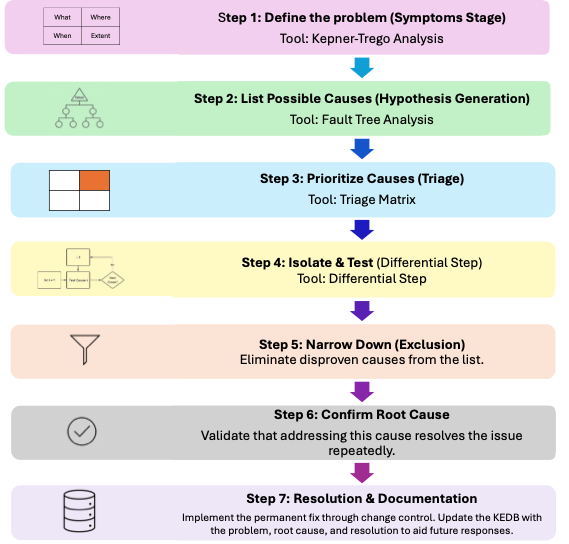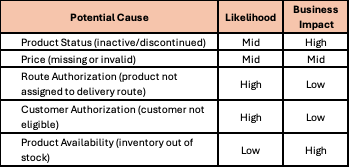Systems Differential Diagnosis Framework
A Structured Approach to Root Cause Analysis
In medicine, symptoms are just the external manifestation of the problem: the true challenge is to identify the disease beneath them. Doctors use differential diagnosis to systematically rule out possible causes until the underlying illness is is identified.
In IT and business systems, we face similar complexity: multiple subsystems, interdependencies, and unexpected failures. Yet too often, teams work to put out the fires, but often not dealing with the true root cause analysis.
This article introduces the Systems Differential Diagnosis Framework (SDDF) — an approach inspired by medicine, designed to help organizations systematically uncover the true issue behind unknown system problems.
Many organizations, today, over-invest in Incident Management (quick fixes) and underuse Problem Management (root cause analysis). The result: recurring issues, mounting costs, and frustrated users.
Problem Management and ITIL Context
The ITIL 4 framework defines Problem Management as the practice of managing the life cycle of all problems, with the goal of preventing incidents from happening or minimizing their impact (AXELOS, 2019).
Despite the availability of tools and frameworks such as 5 Whys, Ishikawa (Fishbone) Diagrams, Kepner-Tregoe (KT) Analysis, Fault Tree Analysis (FTA), among others, many companies use these methods on an isolated or reactive fashion.
The SDDF doesn’t replace these ITIL practices — it organizes them into a systematic workflow, much like doctors sequence diagnostic tools in differential diagnosis.
The Systems Differential Diagnosis Framework (SDDF)
Step 1: Define the Problem (Symptoms Stage)
Collect all available evidence: logs, monitoring alerts, user reports. Frame a clear problem statement: “What is failing? Where? Since when? Under what conditions?”
Step 2: List Possible Causes (Hypothesis Generation)
Brainstorm broadly. For business systems, this may include master data, pricing, customer/route rules, or inventory.
Step 3: Prioritize Causes (Triage)
Rank based on likelihood and business impact. Like in medicine, triage ensures focus on what is most urgent or damaging.
Step 4: Isolate & Test (Differential Step)
Check each cause systematically, ruling it in or out. Compare against a working scenario (healthy system).
Step 5: Narrow Down (Exclusion)
Eliminate disproven causes from the list. Continue refining until one hypothesis consistently matches the evidence.
Step 6: Confirm Root Cause
Validate that addressing this cause resolves the issue repeatedly.
Step 7: Resolution & Documentation
Implement the permanent fix through change control. Update the KEDB with the problem, root cause, and resolution to aid future responses.
Practical Example: Sales System Case
Below is a simplified example for this diagnosis workflow:
Symptom: A sales representative cannot raise an order for a product in the ordering system.
Step 1: Define the Problem (Symptoms Stage)
When the sales representative access the ordering system and after they select the desired customer, Product X is not showing on their screen.
Step 2: List Possible Causes (Hypothesis Generation)
Product Status (inactive/discontinued)
Price (missing or invalid)
Route Authorization (product not assigned to delivery route)
Customer Authorization (customer not eligible)
Product Availability (inventory out of stock)
Step 3: Prioritize Causes (Triage)
Step 4: Isolate & Test (Differential Step) & Step 5: Narrow Down (Exclusion)
Step 6: Confirm Root Cause
When adding the product to the Customer Authorization List and refreshing the system, the product appears available for ordering on the desired customer.
Step 7: Resolution & Documentation
Capture on Knowledge Error Data Base (KEBD)
Result: The SDDF guided the team quickly to the real issue, avoiding days of escalations.
Why This Framework Matters
The SDDF provides:
Repeatability: Teams follow a structured process, reducing guesswork.
Efficiency: Focus is on the most probable and impactful causes first.
Prevention: True root causes are addressed, reducing recurring incidents.
Cross-Functional Value: Works equally well in IT infrastructure and business systems like ERP, CRM, or sales platforms.
Related Approaches and References
The SDDF aligns with established root cause analysis methods such as:
5 Whys (Ohno, 1988).
Ishikawa Diagrams (Ishikawa, 1968).
Kepner-Tregoe Analysis (Kepner & Tregoe, 1965).
Fault Tree Analysis (Watson, 1961).
By integrating these tools into a structured diagnostic sequence, the SDDF rather than compete with ITIL Problem Management, it complements it, giving teams a practical workflow to apply the theory.
Conclusion
Complex systems — whether human bodies or enterprise platforms — require structured approaches to diagnosis. Just as medicine has long relied on differential diagnosis to save lives, technology and business teams can adopt a similar mindset to save services, revenue, and customer trust.
The Systems Differential Diagnosis Framework empowers organizations to move from firefighting to prevention, strengthening ITIL Problem Management and ensuring that solutions target real causes, not just symptoms.
References
AXELOS. (2019). ITIL® Foundation, ITIL 4 Edition. London: TSO.
Ohno, T. (1988). Toyota Production System: Beyond Large-Scale Production. Productivity Press.
Ishikawa, K. (1968). Guide to Quality Control. Asian Productivity Organization.
Kepner, C. H., & Tregoe, B. B. (1965). The Rational Manager. McGraw-Hill.
Watson, H. A. (1961). Launch Control Safety Study. Bell Laboratories.
Written by Ximena Moreno, reviewed by Santiago Mercado




